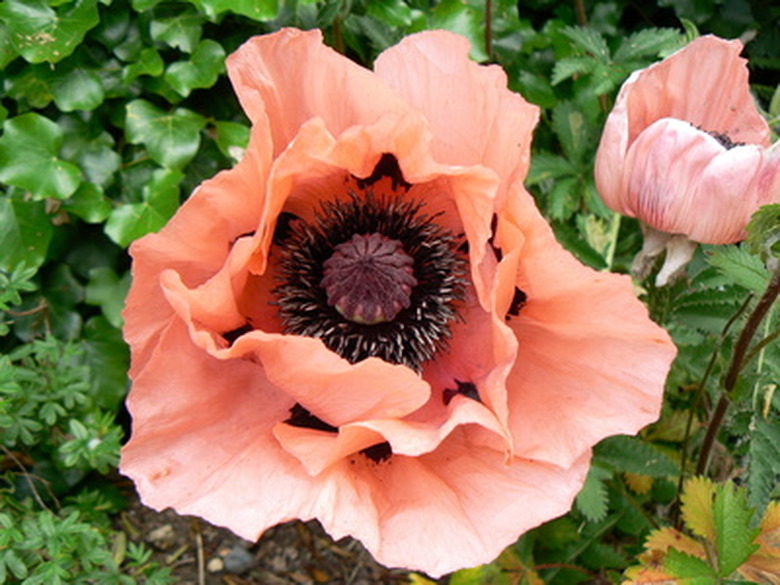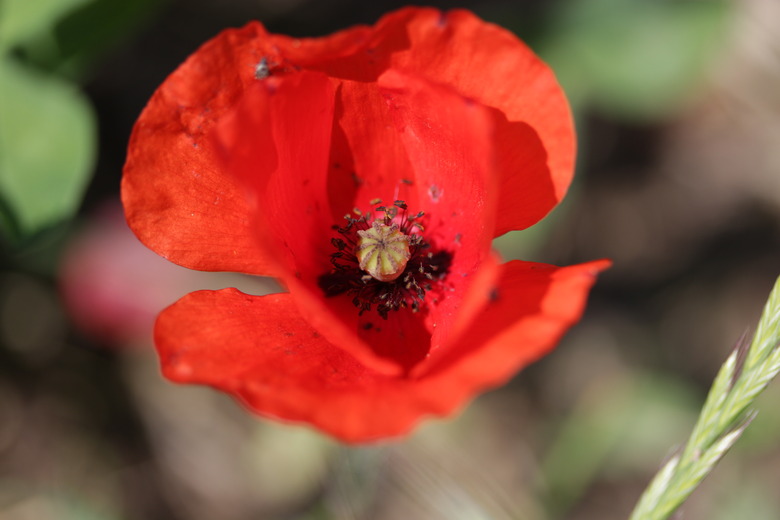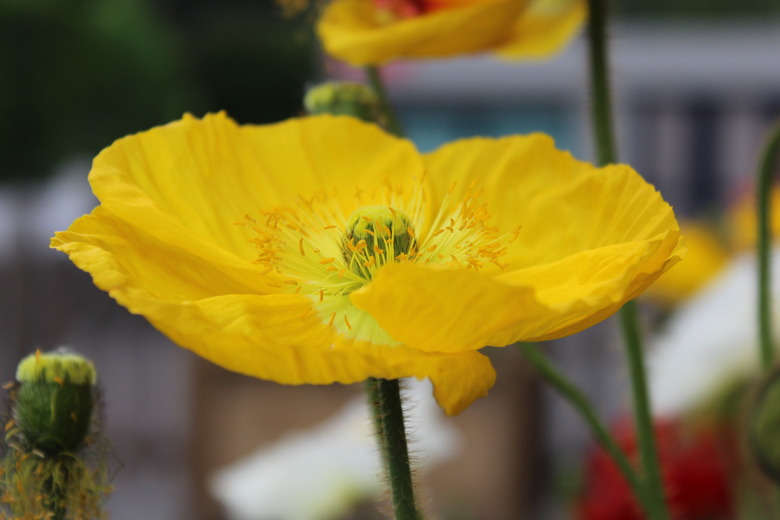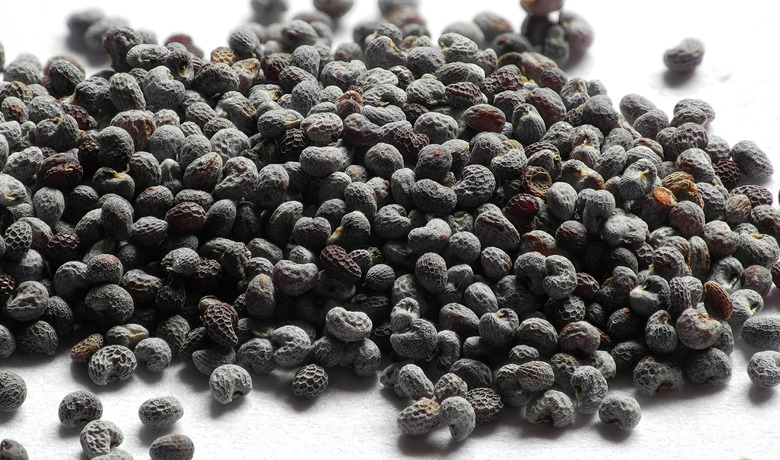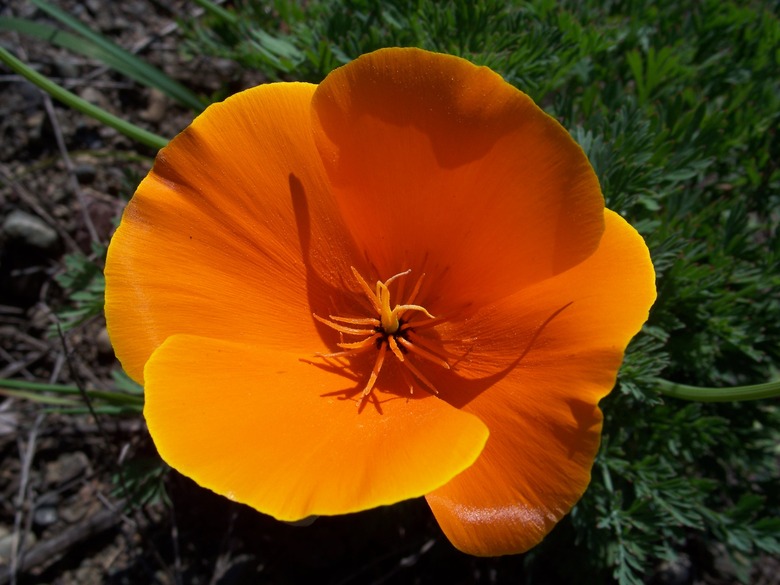Tips On Planting & Growing Poppies
The delicate, tissue-like petals of poppies (Papaver spp.) in colors ranging from white to the palest pinks and yellows to brilliant oranges and reds make poppy flowers lovely additions to formal, informal or cottage gardens.
Hardy in U.S. Department of Agriculture plant hardiness zones 2 to 10 depending on the species, poppies are among the plants that fail to thrive when their roots are disturbed during the transplanting process. Whether annuals or perennials, directly planting poppies in the garden is the best way to ensure that the plants will thrive.
Information About Poppies
Poppies may be annuals or perennials and have single, double or multiple layers of petals depending on the species and cultivar.
Annual Poppies
**Flanders Poppies:** The best known of the annual poppies is the 2- to 3-foot-tall corn or Flanders poppy (Papaver rhoeas). The 2- to 4-inch-wide red blossoms of this annual wildflower covered the disturbed soils and graves of Flanders Fields in Belgium during World War I, inspiring the famous poem "In Flanders Fields" by Lieutenant-Colonel John McCrae.
**Shirley Poppies:** From the corn poppy, plant breeders developed the Shirley poppy cultivars, which feature white, pink, red and multicolored double blossoms.
Perennial Poppies
**Iceland and Oriental Poppies:** Perennial poppies include the Iceland poppy (Papaver nudicaule) and Oriental poppy (Papaver orientale), hardy in USDA zones 2 to 7 and 3 to 7, respectively.
**Breadseed Poppies:** Another option is one or more breadseed poppies (Papaver somniferum), also known as opium poppies, or their feathery cultivars (Papaver somniferum [Laciniatum Group] or Papaver laciniatum). In general, breadseed poppies can be grown for the beautiful blossoms and to harvest the seeds for culinary use, but double-check to ensure the flowers don't fall afoul of local laws.
**Blue Himalayan Poppies:** For something different in dappled or partial shade gardens, consider planting blue Himalayan poppies (Papaver betonicifolium) in USDA zone 3 through 7.
**Celandine and California Poppies:** Other perennial poppies in the Papaveraceae family are the shade-loving yellow celandine poppy (Stylophorum diphyllum), also known as the wood poppy, and the California state flower, the California poppy (Eschscholzia californica). They are hardy in USDA zones 4 through 9 and 8 through 10, respectively. The California poppy is often grown as an annual in zones 6 through 8, reseeding profusely in the garden.
**Mexican Prickly Poppies:** While tough, drought-tolerant and hardy in USDA zones 7 through 10, the Mexican prickly poppy (Argemone mexicana) is not recommended for gardens due to its invasive nature and toxicity.
Warning
All parts of the breadseed poppy are toxic except the seeds. The Mexican prickly poppy is also toxic and can be fatal if large amounts are ingested. In addition, all poppy species produce a latex-like sap, which can cause skin and eye irritation as well as gastric distress. Keep them out of the reach of children and pets.
Preparing the Garden
**Most poppies prefer well-draining soils in a full-sun garden.** The exceptions are the blue Himalayan poppies, which add an exotic flair but are more difficult to grow, and celandine poppies. These poppies prefer a shady garden as well as well-draining, moist soil and cool temperatures.
Here's how to prepare the garden bed in late fall or early spring for poppies:
1. Remove any vegetation, weeds, sticks and rocks. 2. Dig in 2 to 4 inches of well-decomposed compost to a depth of 6 to 12 inches. 3. Rake the amended soil smooth. 4. Wind a soaker hose through the bed to make watering easy. 5. Water so the soil is moist and ready for the seeds.
Adding Compost to Loosen Heavy Soils
While some sources recommend adding sand to clay soils, don't do it. Clay plus sand plus water results in a hard, concrete-like soil structure. Instead, add additional compost to loosen heavy soils.
Compost also adds organic matter to sandy soils, which slows the progression of water and nutrients, making them better available to the poppies and any companion plants.
Adding Raised Beds to Improve Drainage
If the site is extremely poor, rocky or boggy, consider adding raised beds to ensure that water drains away from the plants' roots. Raised beds may be made of bricks, concrete blocks, boards or large rocks. Either loosen the bare soil or cover it with cardboard or several layers of newspaper. Then, fill the bed with a mix of equal parts topsoil or garden soil, compost and coarse sand or pumice.
Planting Poppy Seeds
Poppies need light to germinate. Because the seeds are tiny, consider mixing them with four to five parts fine sand before scattering them over the garden bed or carefully seeding in straight or curved rows.
Press the seeds onto the moist soil to ensure a firm contact but avoid covering with more than a bare scattering of sand, soil or straw. Germination may be as quick as two weeks if the weather is warm or can take four weeks or more if temperatures stay at or below 60°F.
While most annual and perennial poppies flower in their first year of growth, if planted from seed, the Oriental poppies won't bloom until their second year of growth. Plants obtained from the garden center should bloom the first season after transplanting into the garden.
Starting Seeds Indoors
While poppies don't grow well if their roots are disturbed, planting seeds indoors four to six weeks before the last frost date gives a head start on the spring garden.
Use biodegradable peat or paper pots and sand or a sterile seed-starting mix. Press the seeds onto the moistened mix and place them in a brightly lit location. Cover with plastic wrap and keep them moist but not waterlogged until the seeds germinate. Then, remove the covering.
Transplanting Poppy Plants
After all chance of frost has passed, acclimate the poppy seedlings by placing the pots in a sheltered, brightly lit location every day, starting with one hour outside and increasing until the plants are outside all day. To transplant the poppies:
1. Dig planting holes in the garden bed that are twice as wide and slightly deeper than the pots. 2. Carefully tear the top one-third off each pot so no part is exposed to the air after planting the poppy seedlings; the exposed peat or paper will wick moisture away from the plants' roots. 3. Use caution when transplanting poppies in growers' pots to avoid damaging the root balls. 4. Insert each poppy into its planting hole and backfill with the excavated soil. 5. Tamp gently around the root ball and water thoroughly to settle the soil. 6. Cover the soil around the plants with a 2- to 3-inch layer of mulch, pulling it back 4 inches from the plants' stems.
Caring for Poppies
- **Watering:** Water poppies regularly, applying approximately 1 inch of water weekly when the soil is dry to a depth of 1 to 2 inches.
- **Support Structures:** Taller cultivars may need stakes to support the plants in windy locations.
- **Fertilizer:** While poppies don't need a lot of fertilizer, side dress after thinning seedlings and before the plants flower with a shovelful or two of compost or 1 to 2 tablespoons of 21-0-0 fertilizer for every 10 feet of each flower row.
- **Deadheading:** Deadhead the blossoms as they fade to prevent seed pods from forming and self-seeding in the garden.
- **Harvesting:** Near the end of the growing season, allow a few seed heads to mature and harvest for planting in fall or spring. While the annual poppies die after blooming, the perennials may die back to the ground in the heat of summer. Scatter the seeds of heat-loving annuals over the garden bed to hide the bare soil until the poppies reappear.
References
- Emery University – Department of English: Lost Poets – In Flanders Fields
- North Carolina Extension Gardener Plant Toolbox: Papaver rhoeas
- North Carolina Extension Gardener Plant Toolbox: Papaver betonicifolium
- North Carolina Extension Gardener Plant Toolbox: Papaver orientale
- North Carolina Extension Gardener Plant Toolbox: Papaver somniferum
- Washington State University Vegetable Research and Extension: Culinary Poppy
- Missouri Botanical Garden: Eschscholzia californica
- Wisconsin Horticulture Division of Extension: Celandine Poppy, Stylophorum diphyllum
- North Carolina Extension Gardener Plant Toolbox: Argemone mexicana
- Utah State University Extension: Seed Poppy in the Garden
- Iowa State University Extension and Outreach: What Would Be a Good Soil Mix for a Raised Bed?
- Illinois Extension: Does Sand Improve Clay Soil Drainage?
